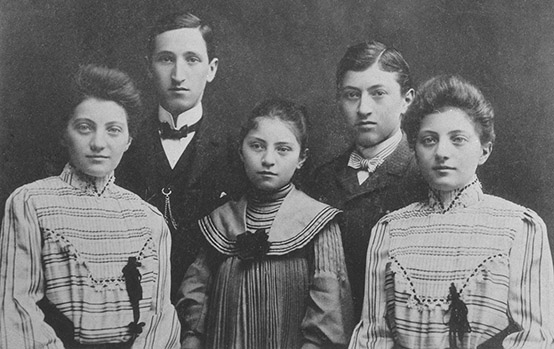Search for Names, Places and Biographies
Already layed Stumbling Stones
Suche
Ernst Nathan Dessauer * 1882
Von-Sauer-Straße 1 b (Altona, Bahrenfeld)
1941 Lodz
ermordet am 12.01.1942
Ernst Nathan Dessauer, born on 20 Jan. 1882, deported on 25 Oct. 1941 to Lodz, date of death 12 Jan. 1942
Ernst Nathan Dessauer was a native of Tübingen in Württemberg. His parents were Adolf and Helene (or Lenchen) Dessauer, née Halle. Apparently, he came to Hamburg in Apr. 1922 and applied for a passport with the local residents’ registration authorities. As a sailor, he required the passport "for seafaring.” By then aged 40, perhaps he merely wished to settle down in the seaport. His physical appearance was recorded: medium build, light brown hair, oval-shaped face, and gray-blue eyes. He indicated bookseller as an occupation. However, he would never apply for a business license.
Ernst Nathan Dessauer professed to be of the Jewish faith, and on 10 Oct. 1928 he became a member of the German-Israelitic Community in Hamburg. At this time, he lived as a subtenant in a rear house on Sophienstrasse, today’s Rothestrasse, in Altona-Ottensen on the slopes of the Elbe River near the Altona harbor. After the National Socialists assumed power, he moved to the "Jewish” Grindel quarter and lived there in changing apartments from 1934 until 1939, always as a subtenant – as recorded by the Jewish Community – on Behnstrasse, Rappstrasse, Rothenbaumchaussee, Rutschbahn, Bogenstrasse, Behnweg, and then on the other side of the Alster on Uhlenhorsterweg. In Nov. 1940, he moved in with the Jewish couple Jacob and Helene Wertheimer in Bahrenfeld at Wagnerstrasse 1b, today’s Von-Sauer-Strasse. Ernst Nathan Dessauer apparently undertook no effort to emigrate – considering he was destitute, that would hardly have been possible anyway.
In June 1941, his father died and left to him a few bonds and about 1,500 RM (reichsmark). However, he did not get a chance to enjoy this little fortune anymore. On 26 Sept. 1941, officers of the Gestapo’s "Jewish Affairs Department” ("Judenreferat”) arrested him and committed him to the Fuhlsbüttel concentration camp. No record of the reason for his detention is available. There were many grounds for the arrest of "non-Aryans.” Perhaps he did not wear the "Jews’ star” ("Judenstern”), which Jews had to attach to their clothes since 19 Sept. 1941. Dessauer stayed in the Fuhlsbüttel concentration camp until 16 Oct.
Immediately afterward, he received the deportation order for 25 Oct. 1941, sent to the address at Wagnerstrasse 1b, third floor; this was only one week after his release. A few weeks later, the deportation order for the main tenants of the apartment, the Wertheimer couple, arrived as well. Ernst Nathan Dessauer was registered under number 184 for the "Jewish transport 1” ("Judentransport 1”) to the ghetto in "Litzmannstadt,” as the Polish city of Lodz had been renamed after the invasion of German troops. One day prior to the deportation, he had to report to the building of the "Lower Saxony Provincial Masonic Lodge” on Moorweidenstrasse, which had been confiscated by the Gestapo. The next day, this large-scale transport departed. Ernst Nathan Dessauer did not survive the first winter in the Lodz Ghetto, dying on 12 Jan. 1942, shortly before his sixtieth birthday.
After the deportation, the assets of the deportees were seized by the state effective immediately. Dessauer’s household effects were auctioned off together with those of his landlords. These public auctions met with considerable interest on the part of the non-Jewish population; after all, it was possible to acquire sought-after but rare household items for far less than their value. The office for the utilization of confiscated assets (Dienststelle für die Verwertung eingezogenen Vermögens) noted that this auction yielded 691 RM (reichsmark). This sum and Dessauer’s inheritance were transferred to the Reich Treasury "for the benefit of the Reich.”
Ernst Dessauer’s sister, Lucie Clara Dessauer, who was 12 years his junior, had been able to reach safety in 1937. She lived in Israel after the war.
Translator: Erwin Fink
Kindly supported by the Hermann Reemtsma Stiftung, Hamburg.
© Birgit Gewehr
Quellen: 1; 2 (R 1998/01/D179 und 30 UA 18); 4; 8; StaH 332-8 Meldewesen, A 24 Band 264 (Eintrag Nr. 6700/1922, Reisepassprotokoll Dessauer); StaH 522-1 Jüdische Gemeinden, 388 c (Angehörige der Deutsch-Israelitischen Gemeinde im Staate Hamburg, ca. 1928); StaH 331-1 II Polizeibehörde II, Ablieferung 15, Band 1 (Abrechnungslisten über Schutzhaftkosten des KZ Fuhlsbüttel); AB Altona; Heuss-Czisch, Barbara/ Lauxmann, Jennifer, Erich Dessauer – Biografie, in: Sammlung Klaus Maier-Ruben; Informationen von Klaus Maier-Ruben; Martin Ulmer, Stationen brüchiger Existenz, Tübinger Zeitung vom 6.11.1996, im Bestand der Geschichtswerkstatt Tübingen.
Zur Nummerierung häufig genutzter Quellen siehe Link "Recherche und Quellen".


